Physical Address
304 North Cardinal St.
Dorchester Center, MA 02124
Given the role of the lymphatic system in developing adaptive responses to numerous antigenic challenges and the rate at which the immune system is exposed to novel antigens early in life, enlarged lymph nodes are regularly encountered both incidentally and within the context of many childhood illnesses. The challenge for the clinician is determining when a change in the size or quality of a lymph node is physiologic or when such a change represents pathology. A thorough history, physical examination, and recognition of the anatomic drainage patterns of the lymphatic system will oftentimes sufficiently narrow the differential diagnosis of lymphadenopathy such that complicated or invasive diagnostic evaluations are unnecessary. It is equally important to consider other non–lymph node disorders in the differential diagnosis (parotids, brachial cleft cysts, primary tumors).
The lymphatic system is a network of vessels and tissues that collects excess fluid from the cellular interstitium and returns it to the peripheral circulation. This interstitial fluid is similar in composition to plasma, though it may contain additional proteins, pathogens, other antigens, and antigen-presenting cells. The collected fluid, termed lymph , enters the lymphatic system via specialized lymphatic capillaries and passes into nearby lymph nodes via afferent lymphatic vessels. The lymph nodes contain both B and T lymphocytes lying in a supportive framework within a connective tissue capsule ( Fig. 48.1 ). Additional lymphocytes may enter lymph nodes from the peripheral venous circulation via postcapillary high endothelial venules. Antigens, antigen-presenting cells, and pathogens within the lymph interact with the lymphocytes, allowing for the production of B- and/or T-cell immune responses in an effort to clear the antigen or pathogen. Efferent lymphatic vessels then carry lymph and antigen-sensitized lymphocytes from the nodes back to the peripheral circulation via the thoracic duct.
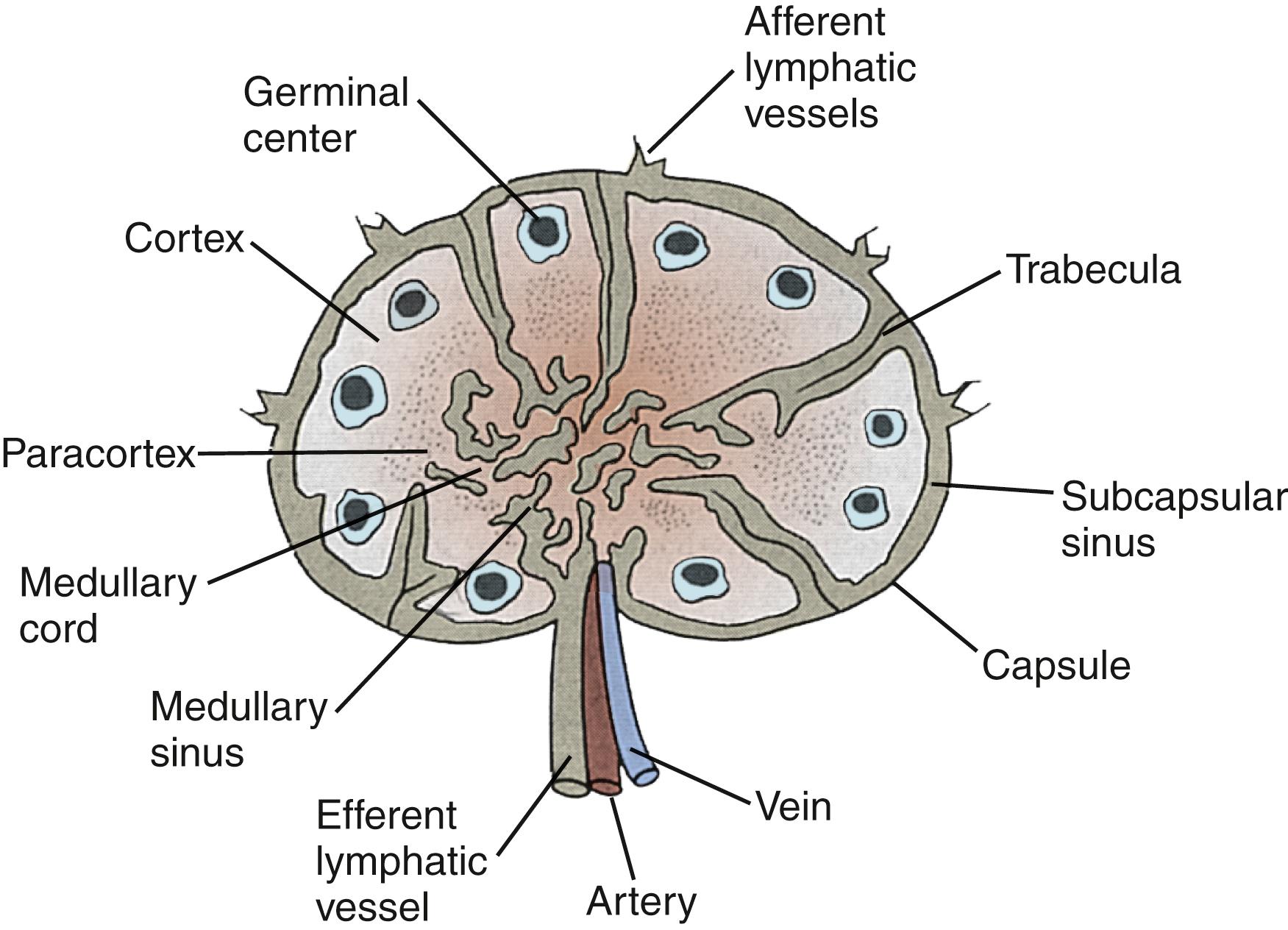
Enlargement of lymph nodes can come about via a variety of mechanisms. First, physiologic hyperplasia can occur as nodal and circulating lymphocytes proliferate within nodes in response to antigenic stimulation. Second, bacteria that have been transported to the nodes may stimulate the recruitment of polymorphonuclear cells and the elaboration of inflammatory mediators that can lead to the edema, erythema, and tenderness characteristic of bacterial lymphadenitis or to suppuration and abscess formation. Third, malignant cells may arise within the node itself and proliferate, causing enlargement, or arrive from distant cancerous sites and infiltrate the nodal tissue. Fourth, certain immune disorders (hemophagocytic lymphohistiocytosis) or immune reactions to medications can cause lymphadenopathy either directly or as part of a serum sickness–like reaction. Finally, in rare genetic storage diseases (e.g., Niemann-Pick, Gaucher diseases), macrophages laden with abnormally metabolized lipids may lodge within lymph nodes, causing enlargement.
The regional drainage pattern of each lymph node group is important in determining the cause of lymphadenopathy, particularly when localized to an individual node or contiguous group of nodes ( Fig. 48.2 and Tables 48.1 and 48.2 ). The cervical lymph nodes drain lymph from distinct areas of the head, neck, and throat and may enlarge if a local infection is present. Consequently, because otitis media and pharyngitis are common infections in children, head and neck lymphadenopathy is one of the more frequently encountered regional lymphadenopathy patterns in small children. The axillary nodes drain lymph from the arms, lateral breasts, and superficial chest and upper abdomen, and isolated enlargement of these nodes may suggest pathology in these areas. The inguinal nodes drain the lower extremities, genitourinary system, and perineum, which may indicate lower extremity pathology or the presence of a sexually transmitted infection in patients with an exposure history. Supraclavicular lymphadenopathy is a concerning finding and should prompt investigation for an underlying neoplasm, fungal infection, tuberculosis, or sarcoidosis. Generalized lymphadenopathy , defined as the presence of enlarged or abnormal lymph nodes in two or more noncontiguous lymph node groups (with or without hepatosplenomegaly), is often indicative of a systemic response to an infectious or otherwise inflammatory process but may also indicate malignant proliferation of lymphocytes ( Table 48.3 ).
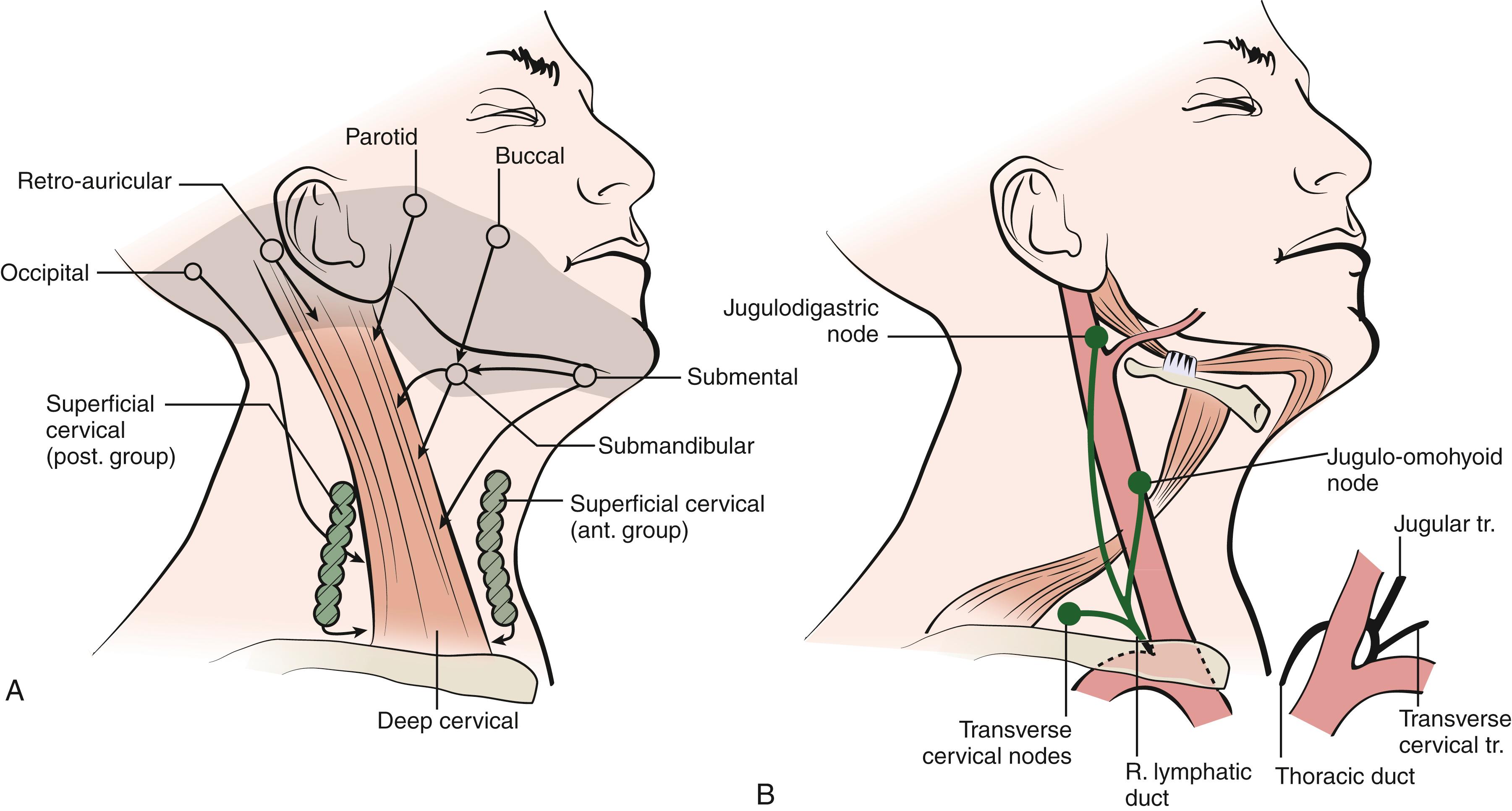
| Abdominal and Pelvic |
|
| Axillary |
|
| Cervical |
|
| Epitrochlear |
|
| Iliac |
|
| Inguinal |
|
| Mediastinal |
|
| Occipital |
|
| Popliteal |
|
| Preauricular |
|
| Submaxillary/Submental |
|
| Supraclavicular |
|
| Cervical |
|
|
|
|
|
|
|
|
|
|
|
|
|
| Anterior Auricular |
|
|
| Posterior Auricular |
|
|
| Supraclavicular |
|
|
|
|
| Epitrochlear |
|
|
|
|
|
|
| Inguinal |
|
|
|
|
| Hilar (Not Palpable, Found on Chest Radiograph or CT) (see Table 48.4 ) |
|
|
|
|
|
|
|
|
|
| Axillary |
|
|
|
|
|
| Neonate | Child | Adolescent |
|---|---|---|
| Common Causes | ||
| CMV | Nonspecific viral infections | Viral infections |
| HIV | EBV | EBV |
| Syphilis | CMV | CMV |
| Toxoplasmosis | HIV | HIV |
| Toxoplasmosis | Measles | |
| Measles | Toxoplasmosis | |
| Syphilis | ||
| Rare Causes | ||
| Chagas disease (congenital) Congenital leukemia Congenital tuberculosis Reticuloendotheliosis Metabolic storage disease Histiocytic disorders Listeria sepsis |
Serum sickness SLE, JIA Leukemia/lymphoma Tuberculosis (miliary) Sarcoidosis DRESS Fungal infections Plague Leptospirosis Brucellosis Langerhans cell histiocytosis Macrophage activation syndrome Hemophagocytic lymphohistiocytosis Castleman disease (very rare in this age group) Chronic granulomatous diseaseSinus histiocytosis (Rosai-Dorfman disease) Kikuchi Fujimoto disease Autoimmune lymphoproliferative disease (ALP) Rickettsial infection |
Serum sickness SLE, JIA Leukemia/lymphoma Tuberculosis Sarcoidosis DRESS Fungal infections Plague Leptospirosis Brucellosis Drug reaction (immune) Castleman disease Rickettsial infection |
History should be aimed at establishing the time course of the development of lymphadenopathy, whether the lymphadenopathy is restricted to a particular anatomic region or is generalized, and if there are any associated signs, symptoms, or exposures that may suggest an etiology.
Lymphadenopathy that develops rapidly over several days is more suggestive of an acutely inflammatory, often infectious process, whereas more indolently developing lymphadenopathy may suggest malignancy, chronic disease, or an atypical infection. The sudden onset of unilateral inguinal adenopathy shortly following lower extremity trauma suggests an infection in the traumatized extremity. In contrast, progressive enlargement of multiple noncontiguous nodal groups over the course of weeks or months that is accompanied by weight loss, fevers, or night sweats suggests a systemic illness such as lymphoma or tuberculosis. When establishing the time period over which the lymphadenopathy developed, clarifying both when the node was first noted to be abnormal and the last time the node was felt to be normal is essential, particularly if associated symptoms, overlying skin changes, and tenderness are absent, since more slowly developing lymphadenopathy may not be noticed until the node or nodes are quite enlarged, or if lymphadenopathy was noted only incidentally when dressing, grooming, or bathing.
The age of the child with lymphadenopathy is similarly important in the consideration of the cause (see Table 48.3 ). Neonatal lymphadenopathy is typically indicative of exposure to an infectious agent in utero, such as cytomegalovirus (CMV), syphilis, HIV, rubella, or toxoplasmosis, though may less frequently be associated with congenital malignancy, immune disorders, or storage diseases. In contrast, toddlers and children with adenopathy tend to have either focal infections that drain into the affected nodal chain, or systemic viral infections, resulting in diffusely enlarged nodes. Adolescents may acquire exposures that place them at risk for sexually transmitted infections and inguinal adenopathy. Just as exposure to certain infectious agents may vary with age, the risk of hematologic malignancy varies as well: Acute leukemias are more common in toddlers and young children, non-Hodgkin lymphoma is more common in school-aged children, and Hodgkin lymphoma is more common in adolescents.
The past medical history and review of systems should be explored for conditions that may either cause lymphadenopathy directly or place the patient at increased risk for opportunistic infections, such as congenital or acquired immunodeficiency. The clinician should inquire about any signs or symptoms that would suggest an acute infectious process or more slowly progressive constitutional symptoms that may suggest malignancy or indolent infection. The quality of oral hygiene practices and dentition should be assessed as odontogenic infections may not readily be appreciated as a source of cervical lymphadenopathy. The use of any prescription medications, over-the-counter medicines, or traditional remedies should be ascertained: In addition to identifying medications that may directly cause lymphadenopathy, this information may identify medications that may cause a serum sickness–like reaction with resultant lymphadenopathy or that may be used to treat autoimmune or rheumatologic conditions that are associated with generalized lymphadenopathy (see Table 48.3 ).
After determining the timing and distribution of the lymphadenopathy and placing these findings within the context of the child’s age and past medical history, the clinician should inquire about any exposures that may have led to the development of lymphadenopathy, focusing in particular on diet, travel history, and contact with individuals, animals, or environments that may pose a risk for disease transmission. Contact with or consumption of raw or undercooked meats, particularly pork, lamb, and venison, may transmit Toxoplasma gondii , leading to toxoplasmosis. Similarly, contact with agricultural animals or ingestion of unpasteurized dairy products may place patients at risk for acquiring certain pathogens, such as Brucella species or Mycobacterium bovis ; infection with either may lead to generalized lymphadenopathy. Potential exposures in the home environment should be assessed, including the risk of contaminated drinking water and whether there are concerns for mold exposure, particularly in immunocompromised patients. The presence of pets, either within the home or in the area, should be determined. Cats or kittens that may scratch the child and transmit Bartonella henselae , the etiologic agent of cat-scratch disease , are often omitted from the history unless such questions are specifically asked. Furthermore, some families may deny the presence of household pets but forget to mention that the child plays with a pet present in a barn or around the neighborhood. Travel history should determine whether the child is from or has been exposed to geographic areas associated with a higher risk for acquiring certain infections, such as tuberculosis in endemically affected nations or histoplasmosis in the Ohio River valley. The clinician should inquire whether any family members or close contacts are ill or taking medications, whether any have recently traveled to or immigrated from other countries, and whether any have recently been incarcerated. Adolescents should be questioned about risk factors for HIV and sexually transmitted infections, such as syphilis or lymphogranuloma venereum, which may cause generalized or inguinal lymphadenopathy, respectively.
The family history should also focus on potentially heritable conditions, such as autoimmune or rheumatologic disorders, certain hematologic and soft tissue malignancies, and storage diseases that may be associated with noninfectious forms of lymphadenopathy.
Physical examination should assess general appearance and look for findings that may reveal the underlying cause of lymphadenopathy. Examination of the lymphatic system should establish the size, quality, and distribution of any abnormal lymph nodes and should assess for the presence of tenderness or changes in the overlying skin or surrounding tissues.
The threshold beyond which a particular node is considered enlarged varies by nodal group. In general, nodes over 1 cm in diameter are considered enlarged; exceptions include epitrochlear nodes >0.5 cm in diameter and inguinal nodes >1.5 cm in diameter.
The quality of the nodes often yields some clues as to the cause of the adenopathy. The clinician should assess consistency, mobility, shape, tenderness, and whether any changes to the overlying skin or soft tissues are present. The following general patterns are worth noting:
Erythematous, tender, and warm: acute bacterial infection with suppurative adenitis
Tender, nonerythematous, and soft: viral infection or other systemic infection
Firm, hard, rubbery, and nontender: lymphoma or other infiltrating tumor
Hard, matted, immobile, and nontender: primary or metastatic tumor; fibrotic changes following acute infection
All areas in which lymphadenopathy is commonly present should be palpated, including the cervical, auricular, axillary, epitrochlear, inguinal, and supraclavicular areas. If more than two noncontiguous nodal groups are abnormal, without evidence of distinct focal infections inciting the lymphadenopathy within each group, the lymphadenopathy is generalized.
Regional lymphadenopathy usually reflects pathologic processes within the lymphatic drainage distribution of that particular nodal chain (see Table 48.2 ). Several patterns of regional lymphadenopathy should prompt further evaluation. The presence of palpable supraclavicular nodes is often a red flag for a serious illness such as malignancy. Supraclavicular nodes that are palpated on the right side often reflect a mediastinal tumor or invasive mediastinal infection, such as histoplasmosis. Supraclavicular nodes on the left side are often the result of metastatic spread of an abdominal tumor. The presence of either type of node mandates an urgent evaluation, including a CBC with differential; imaging with chest radiography, CT, MRI, or PET scan; and consideration of biopsy. Epitrochlear nodes , if unilateral, commonly indicate the hand or arm as a source of distal infection; however, palpable bilateral epitrochlear lymph nodes usually reflect systemic illness, such as syphilis, sarcoidosis, or lymphoma. Inguinal node enlargement is common and is usually caused by the frequent occurrence of minor trauma and infections in the lower extremities of children. Significantly enlarged inguinal nodes may also be present with sexually transmitted infections, such as syphilis, chlamydial urethritis, or lymphogranuloma venereum, or with urinary tract infection, lymphoma, or abdominal tumors.
Mediastinal adenopathy (or mass) may be detected incidentally, secondary to chest symptoms, or during the evaluation of peripheral but generalized lymphadenopathy. The differential diagnosis is noted in Table 48.4 .
| Anterior Mediastinum |
|
| Middle Mediastinum |
|
| Posterior Mediastinum |
|
Many previously healthy children with acute lymphadenopathy require few, if any, laboratory or imaging studies. No laboratory testing may be required for well-appearing children whose acute, localized adenopathy can be attributed to an infection in the vicinity of the node; similarly, generalized lymphadenopathy clearly associated with a systemic viral infection may not require further evaluation. The differential diagnosis of lymphadenopathy is developed in a stepwise fashion, first by determining whether the lymphadenopathy is regional or generalized. Next, the time course of the lymphadenopathy should be defined as acute or chronic, the latter defined as being present for a period of more than 4 weeks. Finally, the quality of the nodes and the presence of any associated signs or symptoms should be ascertained, as the extent of evaluation is dictated by both the characteristics of the lymphadenopathy and the presence of associated signs and symptoms. Using this approach, a comprehensive differential diagnosis and evaluation plan can then be developed ( Figs. 48.3 and 48.4 ).
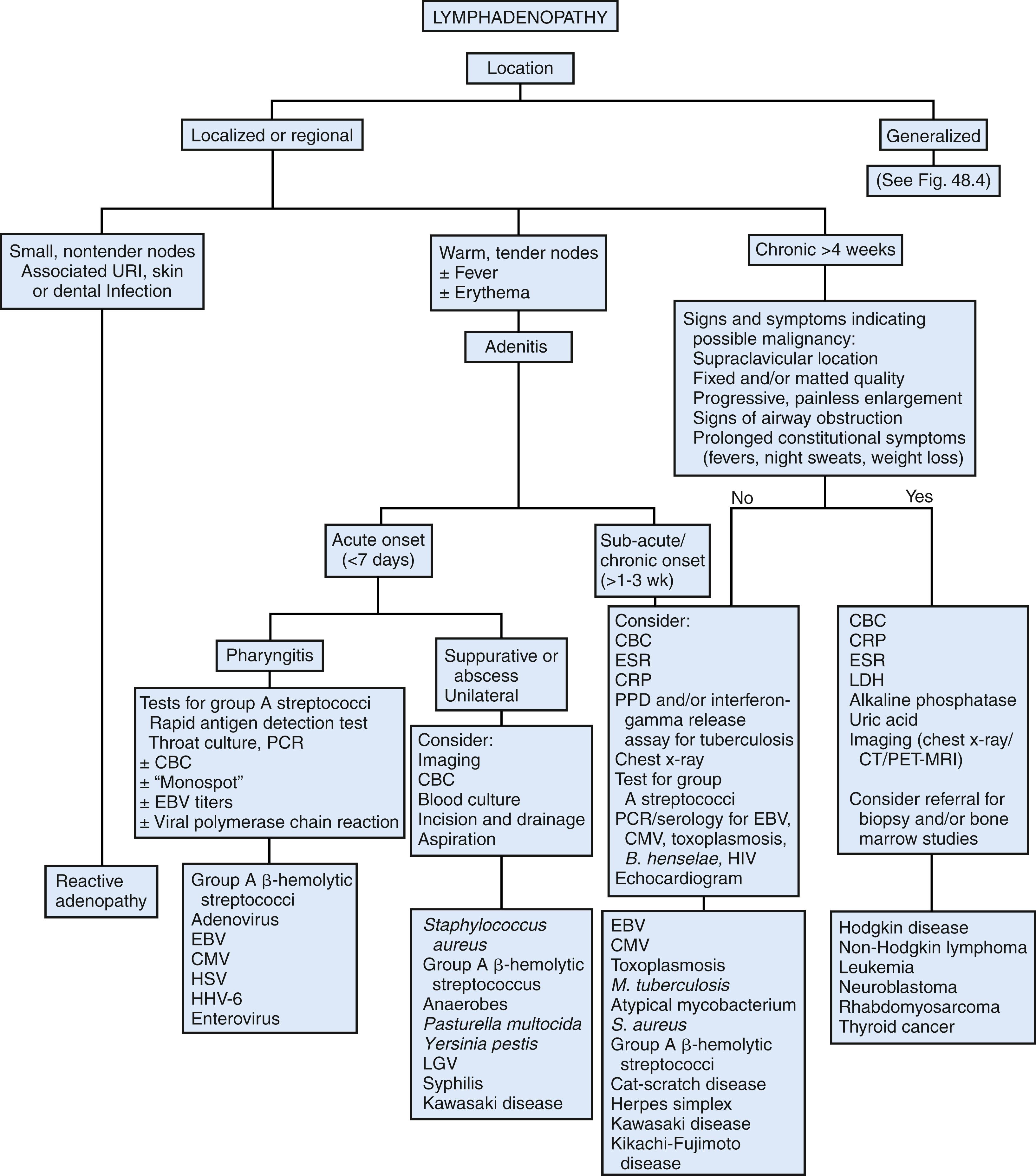
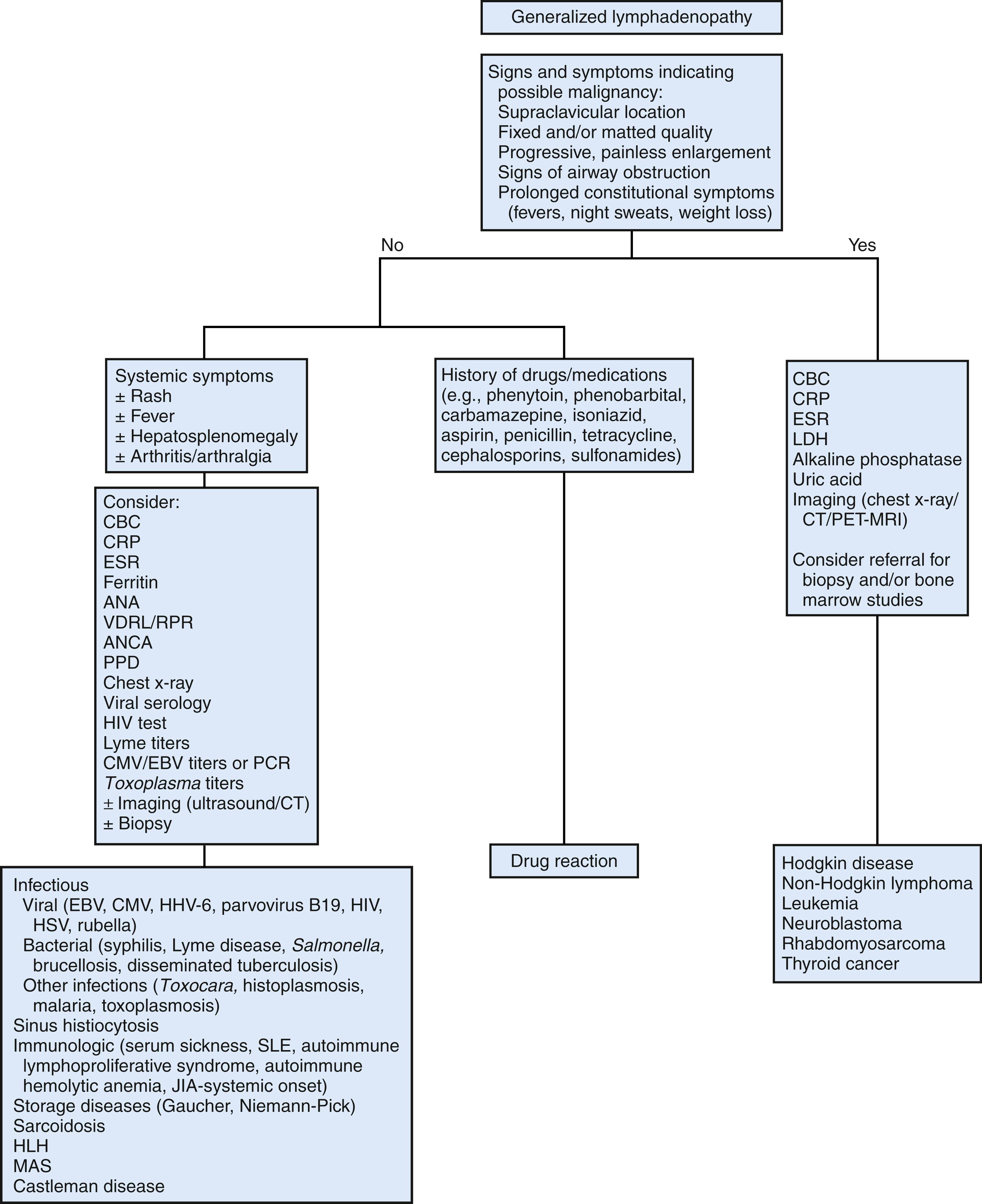
The typical child with acute regional lymphadenopathy presents with enlarged nodes, commonly in the cervical region. A thorough history and careful physical examination should reveal whether nodes are definitely involved, as opposed to other non-nodal structures, such as salivary glands. In many cases, no other abnormalities are found on examination, systemic signs are minimal, and no further evaluation is required. Acute cervical lymphadenopathy in the presence of upper respiratory infectious symptoms often requires only observation. In the child whose presenting features are only fever and an acutely inflamed unilateral cervical lymph node, bacterial lymphadenitis should be considered. Laboratory tests should include a CBC and differential as well as measurement of inflammatory markers such as the ESR, CRP, or procalcitonin level. A trial of oral antibiotics (with activity against mouth flora, streptococci, and staphylococci) may be considered; if the lymphadenopathy persists or worsens, intravenous antibiotics may be indicated, as should be consideration of diagnoses other than acute unilateral bacterial lymphadenitis, such as lymphadenitis from tuberculosis or atypical mycobacteria. In those instances, if clinical signs or exposure history are suggestive, a purified protein derivative (PPD) or interferon gamma release assay should be undertaken, and if the results are negative and symptoms improve on the intravenous antibiotics, it is reasonable to complete the antimicrobial course orally.
In contrast, if the lymphadenopathy continues or becomes frank lymphadenitis with erythema and tenderness despite antimicrobial therapy, further work-up is indicated. Imaging the involved area is helpful but not always necessary. Although ultrasonography can reveal enlarged nodes or a fluid-filled abscess or cyst, contrast-enhanced CT of the area is the best method for defining the extent of inflamed nodes and whether an abscess is present ( Fig. 48.5 ). If an abscess is found, incision and drainage, followed by appropriate bacterial and mycobacterial cultures and stains, are appropriate. If atypical mycobacteria are suspected on the basis of a borderline positive PPD or cross-reacting gamma interferon release array result or clinical presentation, fine-needle aspiration or excisional biopsy is preferred because incision and drainage often lead to draining sinus tracts that are difficult to heal ( Fig. 48.6 ). Enlarged nodes that do not recede in several weeks with appropriate antimicrobial therapy and without explanation (such as acute Epstein-Barr virus [EBV] infection) should also raise the suspicion of malignancy.
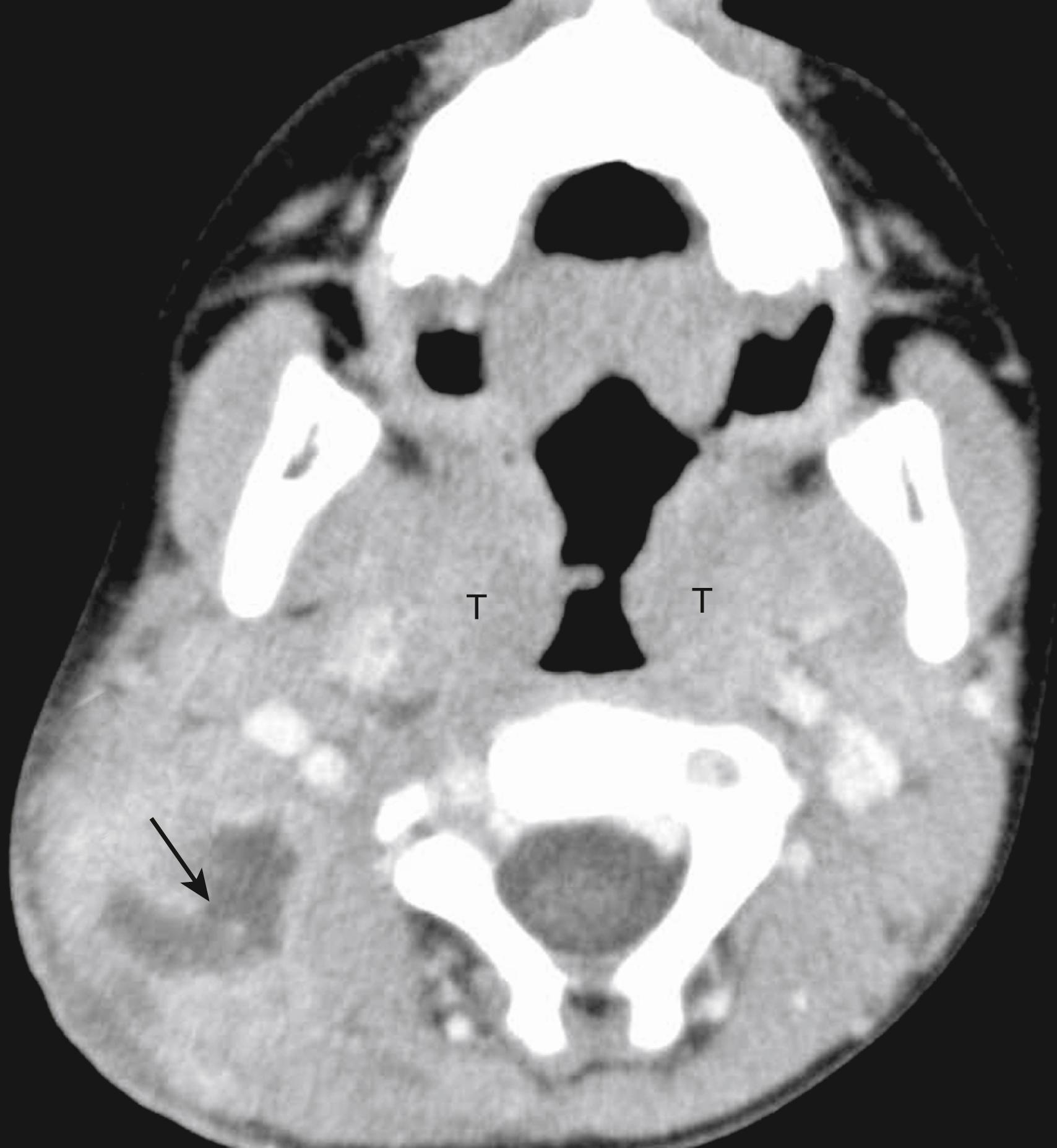
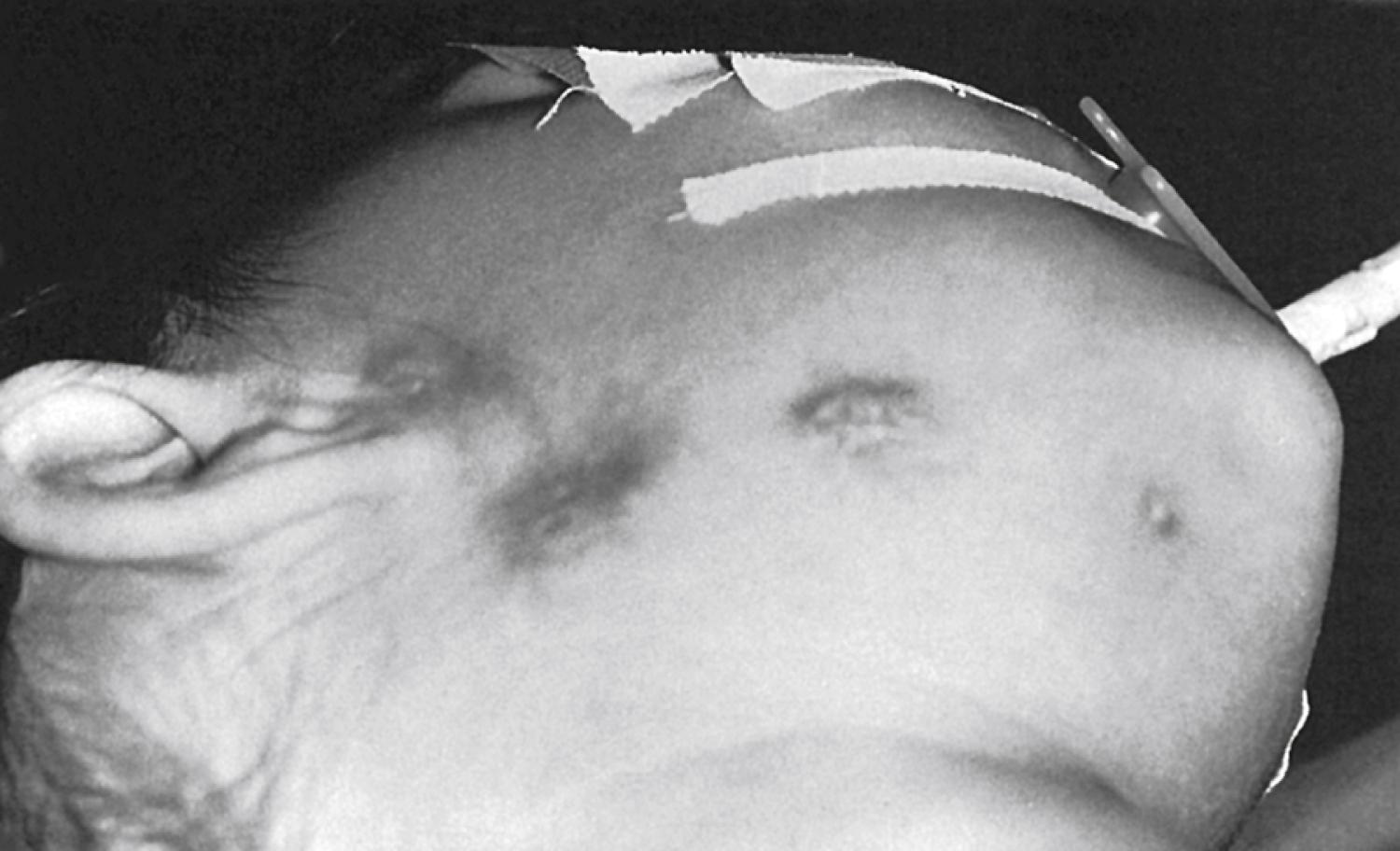
The presence of additional signs or symptoms should prompt consideration of alternate diagnoses. Acute cervical lymphadenopathy accompanying pharyngitis in children older than 18 months may necessitate testing for group A streptococci. The additional presence of hepatomegaly or splenomegaly should raise suspicion of EBV-related infectious mononucleosis, in which case a CBC with white blood cell differential (to identify lymphocytosis and atypical lymphocytes) ( Table 48.5 ) and EBV titers (or a monospot heterophile antibody test in older children) may be helpful.
|
|
|
|
|
|
|
|
∗ Cytomegalovirus is the most common cause of heterophile-negative mononucleosis.
Supraclavicular adenopathy, acute cervical adenopathy accompanied by respiratory distress, or prolonged cervical adenopathy warrants anteroposterior and lateral radiographs of the neck and/or chest, a CBC with white blood cell differential, and interferon gamma release assay or placement of PPD tuberculin skin test. CT with contrast is necessary in certain situations to fully delineate cervical adenopathy that is excessively large or that impinges on the airway, or to determine whether mediastinal adenopathy is also present. Empiric glucocorticoid therapy, often considered in an attempt to reduce discomfort associated with inflamed nodes, usually in the head and neck area, should not be administered without definitively establishing the etiology of lymphadenopathy, as such treatment can delay or obscure the diagnosis of hematologic malignancy, and prior glucocorticoid therapy in the setting of hematologic malignancy can portend a higher risk classification and ineligibility for certain oncology treatment protocols. Exceptions may be considered in instances of impending critical airway obstruction secondary to severely enlarged cervical lymph nodes.
In the child with generalized lymphadenopathy, the cause may be infectious, immunologic, or malignant. Infectious causes, such as HIV, EBV, CMV, toxoplasmosis, and secondary syphilis, can generally be determined relatively quickly through serologic or nucleic acid–based testing. Noninfectious causes, such as systemic lupus erythematosus, macrophage activation syndrome, hemophagocytic lymphohistiocytosis, and serum sickness, can also generally be excluded by a thorough history and specific laboratory studies. Drugs may cause serum sickness or produce hypersensitivity reactions, either of which may result in generalized lymphadenopathy. Medications associated with drug-induced lymphadenopathy include allopurinol, atenolol, captopril, carbamazepine, gold, hydralazine, penicillins, phenytoin, primidone, procainamide, pyrimethamine, quinidine, sulfonamides, sulindac, and tetracyclines. If the generalized lymphadenopathy cannot be attributed to a definite cause, if the nodes fail to recede within several weeks, and especially if there are systemic symptoms, malignancy must be considered. An abnormal CBC demonstrating anemia, leukopenia, or thrombocytopenia, or radiologic evidence of mediastinal adenopathy or pleural disease is highly suggestive of malignancy. HIV, EBV, and CMV studies (culture, polymerase chain reaction [PCR], and serologic profiles) may be obtained for some children. Because the diagnoses of leukemia (through bone marrow aspiration, biopsy), lymphoma (through bone marrow aspiration, biopsy), systemic lupus erythematosus (through antinuclear antibody, double-stranded DNA antibodies), and cat-scratch disease (through biopsy and/or B. henselae serologic profile) require more invasive and expensive tests, the physician should first consider all aspects of the history and physical examination before ordering laboratory studies. Because serious disseminated infections, such as tuberculosis and histoplasmosis, can manifest in a similar manner, fine-needle aspiration or biopsy of an involved node or bone marrow aspiration is crucial. Excision of a node is preferred in some cases to obtain adequate tissue for pathologic study, stains, or cultures.
Several patterns of lymphadenopathy and their underlying causes deserve special mention, due either to the frequency with which they are encountered in pediatric practice or to the potential severity of the underlying cause.
Pharyngeal infection is the most common cause of regional lymphadenopathy in children (see Chapter 2 ). Many of these pharyngeal infections are associated with cervical lymphadenopathy and are viral in origin. Frequent viral causes include adenovirus, parainfluenza, influenza, rhinovirus, coronaviruses (including severe acute respiratory syndrome-coronavirus 2 [SARS-CoV-2]), and enterovirus. EBV and CMV also commonly cause exudative pharyngitis and cervical lymphadenopathy. The chief complaint usually includes pain with swallowing and with talking, as well as tender, enlarged lymph nodes in the neck. Systemic manifestations, such as fever, myalgia, chills, and rhinorrhea, may also be present. An examination of the throat typically reveals a symmetrically erythematous posterior oropharynx with enlarged tonsils that often contain exudates. Exudates can be seen with both viral and bacterial causes of pharyngitis and adenopathy, and thus do not reliably discriminate between the two causes. Herpes stomatitis with mucocutaneous involvement and herpes pharyngitis with oropharyngeal vesicles are also associated with bilaterally enlarged, tender, nonerythematous cervical nodes.
Bacterial infection of the pharynx is also commonly associated with enlarged, tender cervical lymph nodes. Strains of group A β-hemolytic streptococci are the most common causes of such infections and are difficult to differentiate clinically from viral causes of pharyngitis and lymphadenopathy; thus, throat culture, PCR, or rapid antigen detection is necessary. An associated sandpapery rash and beefy-red tonsils with palatal petechiae are not usually seen with viral pathogens and should make the examiner consider group A streptococci and toxin-mediated scarlet fever as a likely cause. Other bacteria can cause pharyngitis and cervical adenopathy, including non–group A streptococci and anaerobic organisms, such as Fusobacterium species. Anaerobic organisms can lead to painful oral gingivitis or stomatitis and pharyngitis (Vincent angina) that may progress to peritonsillar abscess. Asymmetry in the tonsils and surrounding tissues, as well as deviation of the uvula away from the affected side, may be seen with peritonsillar abscesses, along with unilateral tender, enlarged cervical lymph nodes ipsilateral to the abscess. Complications of acute bacterial pharyngitis may also include Lemierre syndrome , the findings of which include high fever and unilateral lateral neck swelling that may be confused with adenopathy. Lemierre syndrome is due to septic thrombosis of the internal jugular vein (and pulmonary septic emboli), usually caused by invasion of the bloodstream by Fusobacterium organisms, and should lead to prompt hospitalization, blood cultures, treatment with intravenous antibiotics, and imaging of the internal jugular vein via Doppler flow ultrasonography or contrast-enhanced CT.
Acute cervical lymphadenitis —inflammation of the cervical lymph nodes with tender enlargement—is most likely to occur with group A streptococcal or Staphylococcus aureus infection. There may or may not be a history of sore throat or pharyngeal inflammation on examination. Infection with other oral bacteria, including non–group A streptococci and anaerobes such as Fusobacterium or Arcanobacterium species, may also occur, presumably with the pharynx as the portal of entry. Other common sites for acute lymphadenitis are the submandibular nodes. Usually, these nodes quickly diminish in size after institution of appropriate antibiotic therapy, providing some degree of retrospective diagnosis while simultaneously being therapeutic.
Suppuration and spontaneous drainage of the nodes are less common than adenitis and are not typically seen in the setting of viral infections. Acute suppurative cervical adenitis can be seen in infections of the face and scalp and is usually caused by infection with group A streptococci or S. aureus . Management of suppuration includes incision and drainage or excision of the suppurative node. Gram stain and bacterial, fungal, and mycobacterial cultures of the drainage should be obtained. If there is concern for mycobacterial disease, a tuberculin skin test should be placed and/or interferon-γ release assay should be performed. Total excision should be performed if atypical mycobacterial infection is suspected, because draining fistulas may form if a needle biopsy or partial resection is performed. Fine-needle aspiration may reduce the risk of sinus formation.
Bacterial infections of the skin and soft tissues are common causes of localized lymphadenopathy and adenitis and can lead to axillary or inguinal adenopathy if these infections originate in the extremities. Primarily caused by group A β-hemolytic streptococci or S. aureus , these infections may drain into and inflame single or multiple regional lymph nodes. Any laceration or insect bite that becomes infected may yield adenopathy upstream in the nodal drainage basin of the infected site. Occasionally, penetrating injuries to the feet occurring through damp shoes or in wet areas may yield infections with other bacteria, such as Pseudomonas aeruginosa . These penetrating infections usually manifest with cellulitis or osteomyelitis; lymphadenopathy is noted during the physical examination. The most common sites of infection include the foot or leg, leading to unilateral inguinal lymphadenitis, and the hand or arm, causing axillary lymphadenitis or unilateral inflammation of the epitrochlear nodes. Sporothrix schenckii , a fungus found in soil and on plant surfaces, can also produce regional lymphadenopathy after a minor penetrating injury, such as pricking a finger or toe on a rose thorn. Sporotrichosis presents as a small nontender nodule at the site of entry that over days to weeks spreads via lymphatic channels, producing ulcerating nodules along the lymphatic drainage pathway and either axillary or inguinal adenopathy, depending on the site of inoculation.
Infection with EBV is a common cause of both regional (bilateral cervical) and diffuse lymphadenopathy (see Chapter 2 ). This virus classically causes a mononucleosis syndrome in adolescents ( Fig. 48.7 ), consisting of acute pharyngitis that may have a prolonged course, with tender and firm cervical adenopathy, malaise, fever, weight loss, and anorexia. Nearly half of patients will have generalized lymphadenopathy as well. More than 80% of patients have mild hepatitis (transaminitis) that is clinically silent but can be documented with liver enzyme studies; approximately 10% become jaundiced. Splenomegaly is present in more than 50% of patients and, in rare cases, progresses to splenic rupture. A small number of patients also have parapharyngeal and tonsillar lymphoid hyperplasia, which causes difficulty swallowing or breathing and can produce significant problems, leading to dehydration or airway obstruction. Small children with EBV infection often present with atypical symptoms or may be completely asymptomatic. In these children, fever and mild cervical adenopathy may be the major symptoms on presentation, or the child may be significantly ill with high fever and pharyngitis. In some, a nonspecific rash, appearing often after beginning empiric antibiotic therapy with penicillins, will suggest the diagnosis. Young children with acute EBV infection are more likely to have hepatosplenomegaly, rash, and eyelid edema than are young adults.
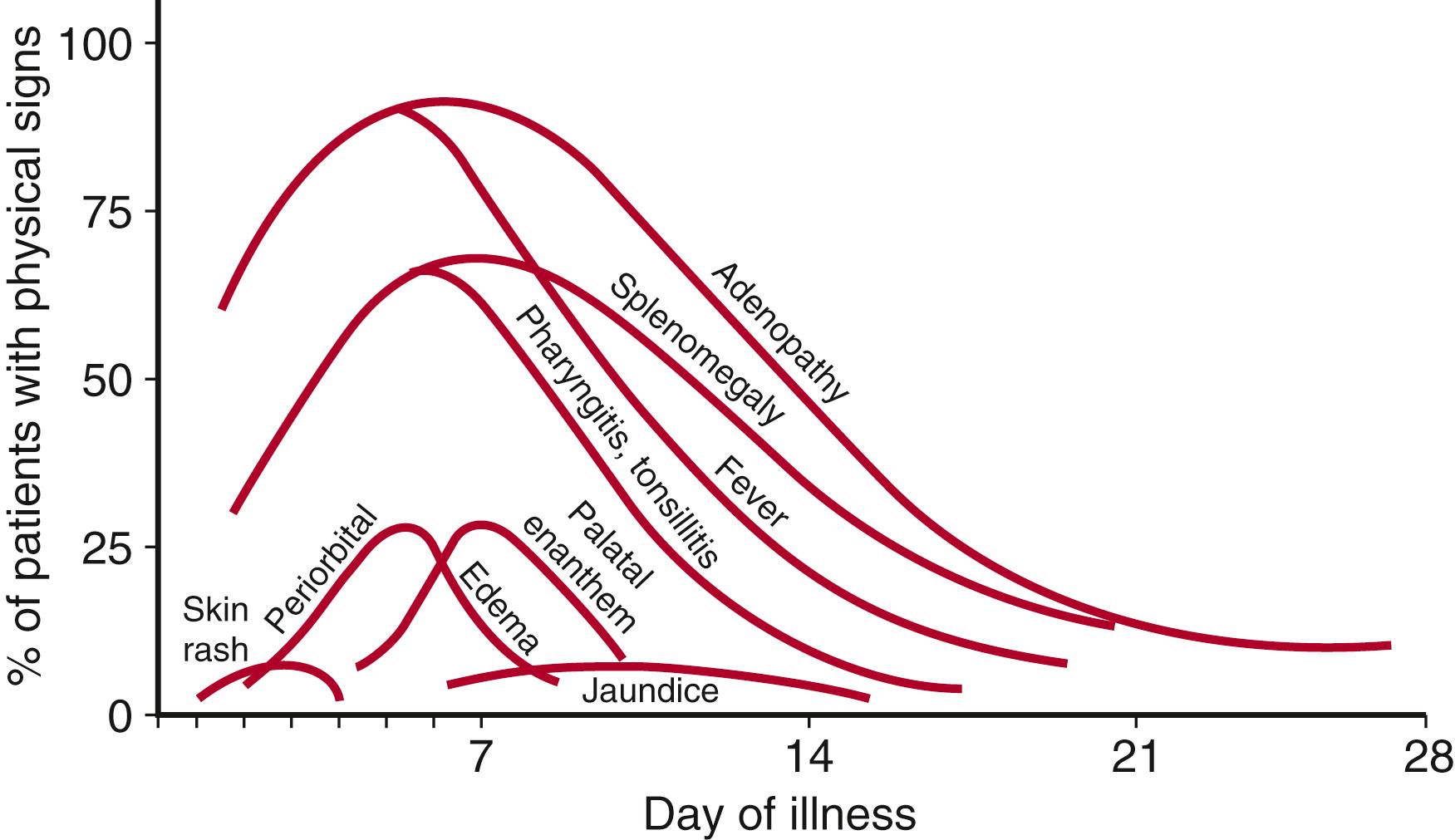
The diagnosis of EBV infection in older children focuses on the characteristic clinical syndrome and a relative lymphocytosis of 40–50% seen in the differential white blood cell count, with up to 20% atypical lymphocytes. Heterophile immunoglobulin M (IgM) antibodies, which are non-EBV directed and agglutinate sheep and horse red blood cells, are found in more than 80% of young adults with EBV and are at maximal titer 3–4 weeks after infection. Heterophile antibodies are rarely found in children younger than 5 years with EBV infections. In young children, antibody titers directed to specific EBV antigens are necessary to confirm the diagnosis ( Table 48.6 ). Temporally, IgM and immunoglobulin G (IgG) antibodies develop against the viral capsid antigen (VCA) first, followed by antibodies directed against early antigen (EA). Antibodies to nuclear antigens develop weeks later and, if present with EA IgG, are indicative of infection in the recent past. Approximately 20% of children present after the VCA IgM has already declined. In these children, VCA and EA IgG are present.
| Antibody Specificity | Time of Appearance in Infectious Mononucleosis | Percentage of EBV-Induced Mononucleosis Cases with Antibody | Persistence | Comments |
|---|---|---|---|---|
| Viral Capsid Antigens | ||||
| IgM VCA | At clinical presentation | 100 | 4–8 wk | Highly sensitive and specific major diagnostic utility |
| IgG VCA | At clinical presentation | 100 | Lifelong | High titer at presentation and lifelong persistence make IgG VCA more useful as epidemiologic tool than as diagnostic tool in individual cases |
| Early Antigens | ||||
| Anti-EA-D | Peaks at 3–4 wk after onset | 70 | 3–6 mo | Correlated with severe disease; also seen in nasopharyngeal carcinoma |
| Anti-EA-R | 2 wk to several months after onset | Low | 2 mo to >3 yr | Occasionally seen with unusually severe or protracted illness, also seen in African Burkitt lymphoma |
| Latent Antigen | ||||
| EBV nuclear antigen | 3–4 wk after onset | 100 | Lifelong | Late appearance helpful in diagnosis of heterophile-negative cases |
Organ transplant and other immunosuppressed patients may develop a lymphoproliferative syndrome due to EBV that presents with generalized lymphadenopathy, hepatosplenomegaly, and fever. Diagnosis is based on the EBV viral load determined by PCR on blood.
Because group A streptococcal infection can present in a similar manner, or be present simultaneously with EBV infection, and because other viruses can cause pharyngitis and tender, enlarged cervical lymph nodes, differentiating these various causes of pharyngitis and lymphadenopathy is important. Acute streptococcal pharyngitis can be identified on throat culture, PCR, or antigen testing and improves after institution of penicillin therapy; EBV infections do not improve with antibiotics, tend to result in a diffuse rash if treated with penicillins, and have a more prolonged clinical course. In addition, severe malaise and splenomegaly do not occur with most bacterial or viral causes of pharyngitis and cervical lymphadenopathy, and these findings should prompt the clinician to consider EBV infection. Similarly, most viral causes of cervical adenopathy and pharyngitis, with the exception of CMV, are not associated with the brisk atypical lymphocytosis commonly seen with EBV infections, and they are not usually associated with abnormal liver function results.
Become a Clinical Tree membership for Full access and enjoy Unlimited articles
If you are a member. Log in here